Lauki Paratha are flavorful flatbreads from North India, made with whole wheat flour, grated bottle gourd (lauki), spices, and herbs. Lauki, also known as opo squash or long melon, is a common ingredient in Indian cuisine and adds a unique taste to these parathas. The grated bottle gourd is mixed with flour and spices to form the dough, which is then rolled out and cooked. This method infuses the flatbread with the subtle flavors of lauki, making it a nutritious and delicious meal option.
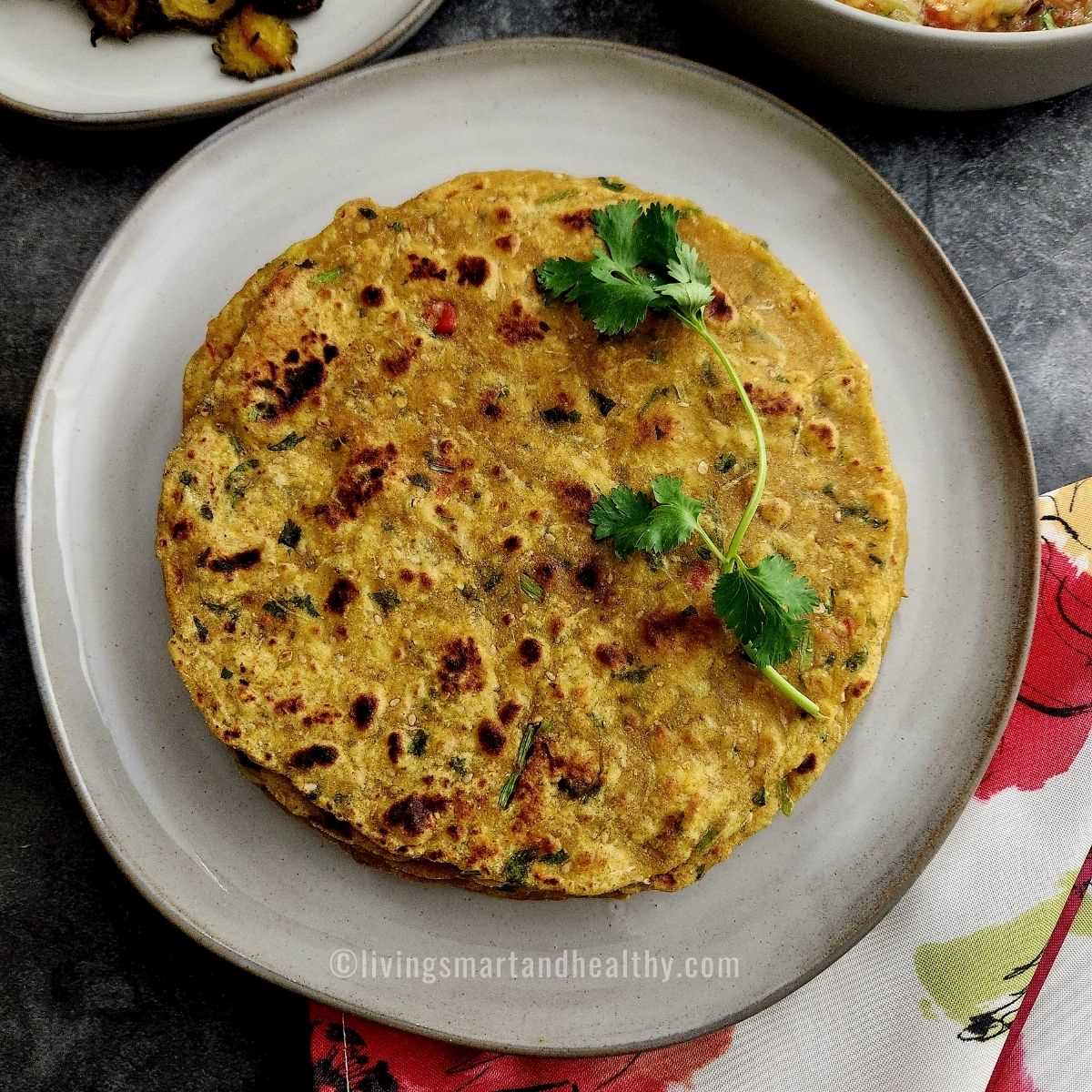
Lauki Paratha are flavorful flatbreads from North India, made with whole wheat flour, grated bottle gourd (lauki), spices, and herbs. Lauki, also known as opo squash or long melon, is a common ingredient in Indian cuisine and adds a unique taste to these parathas. The grated bottle gourd is mixed with flour and spices to form the dough, which is then rolled out and cooked. This method infuses the flatbread with the subtle flavors of lauki, making it a nutritious and delicious meal option.
Parathas come in two varieties: stuffed and non-stuffed. While stuffed parathas require some practice to perfect, non-stuffed parathas are easier to make and only require evenly rolling out the dough with a gentle touch.
Jump to:
About Lauki Paratha
Lauki paratha is a healthy and delicious Indian flatbread made with the goodness of freshly grated bottle gourd (Opo squash) and whole wheat flour.
These lauki parathas are perfect as breakfast or even snacks with your evening tea/coffee. Stays good for up to a week, and freezes well.
Lauki paratha is made with a combination of flour like whole wheat, besan (chickpea flour), optional bajri flour (Millet flour), or Jowar ( Sorghum Flour ), freshly grated lauki or bottle gourd, and some Indian spices.
These lauki parathas are easy to make since they aren't stuffed. You simply mix the grated bottle gourd into the dough, roll it out, and cook the parathas on a griddle with ghee or oil. They can be made thick or thin, depending on your preference, and served hot or cold with yogurt, Tomato Chutney, Strawberry Jam, pickles, or a piping hot cup of tea. When the dough is well-spiced, they’re delicious even on their own.
My kids are picky about eating bottle gourd, so I often make these parathas or Lauki Kofta curry, both of which include grated bottle gourd. The parathas can be made simply with just whole wheat flour, bottle gourd, coriander leaves, chilies, garam masala, red chili powder, and salt.
I often add fenugreek leaves or spinach and a bit of turmeric for color, as seen in the first picture. For a variation, you can make lauki thepla by replacing some of the wheat flour with bajra, jowar, or besan. These parathas are great for school or office lunch boxes and pair well with plain yogurt.
If you're planning to make these parathas in the morning, you can grate the bottle gourd the night before and store it in the refrigerator. Using a stand mixer or food processor to make the dough makes the process quicker, allowing you to roll out the parathas right after kneading. These lauki parathas can be refrigerated for up to two days and can be reheated by steaming.
Paratha can be made with different veggies like zucchini, fresh fenugreek leaves, lauki ( bottle gourd ), beetroot, or fresh leafy vegetables. Depending upon the ingredients used the taste and texture of the paratha may vary.
Similar recipes:
- Zucchini Paratha
- Palak Paratha
- Tofu Paratha
- Multigrain Methi Thepla
- Microgreens Methi Thepla
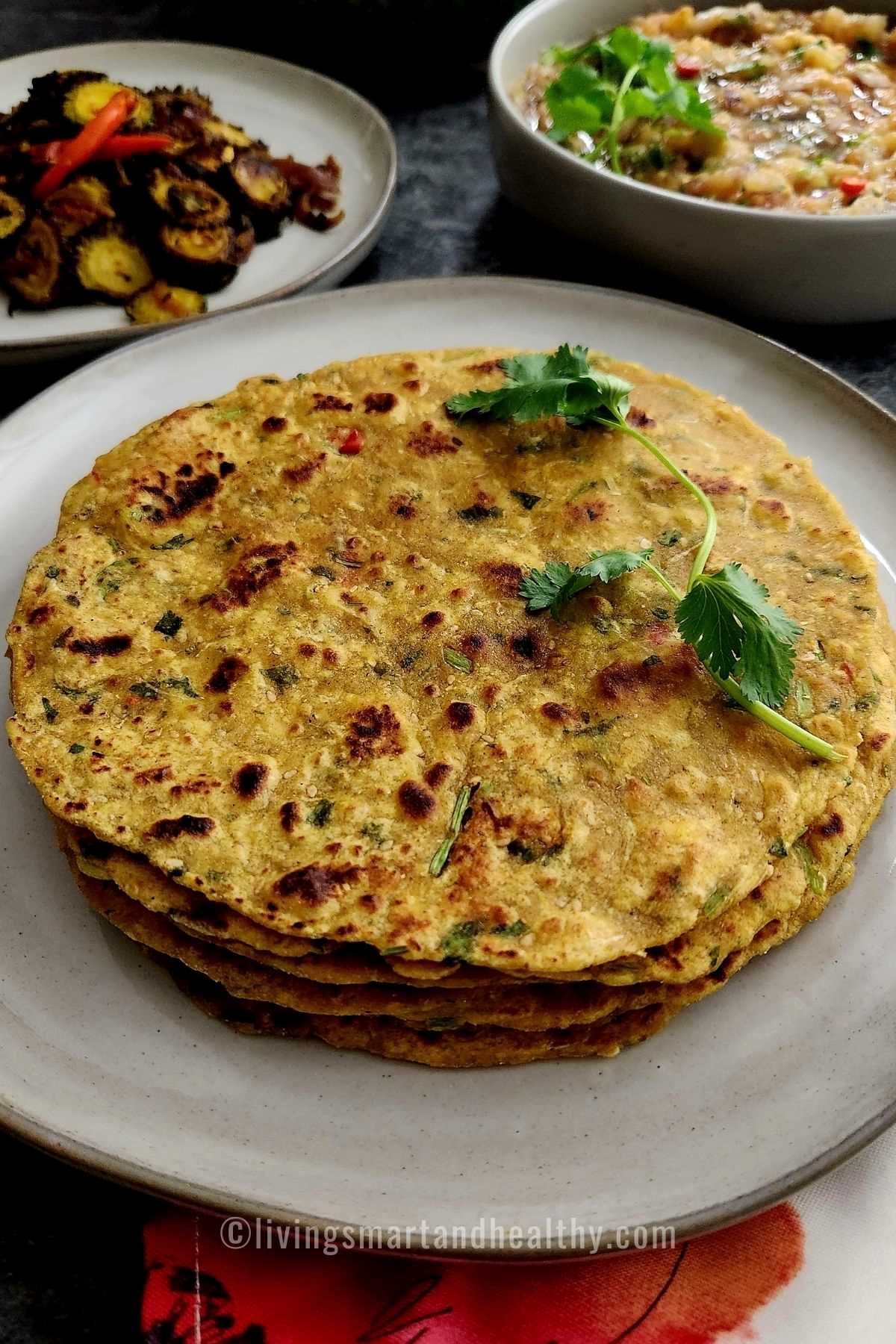
Ingredients For Lauki Paratha
Bottle Gourd (Lauki/Dudhi): I used grated bottle gourd or Opo squash about 2 cups for this recipe.
It is important to note here that lauki releases a lot of moisture. Do not keep the dough for a long time.
Atta (Wheat Flour): I used 100% whole wheat flour, atta from an Indian grocery store.
Besan (Chickpea Flour): Along with whole wheat flour, I used some chickpea flour for added flavor. Chickpea flour is used in a very small quantity, do not add too much or the paratha will turn out dry.
Bajra or Jowar Atta (Millet or Sorghum Flour): Besides atta and besan, you can also add some Millet flour or Sorghum flour. It is optional, but you can add some for added flavor and nutrient value.
Green chili: Green chilies provide heat to the paratha. The amount can be adjusted according to personal spice preferences.
Ginger: Ginger adds a fresh and slightly spicy taste to the paratha. It also has digestive and anti-inflammatory benefits.
Cilantro: Coriander leaves, also known as cilantro, are used for their fresh and citrusy flavor. They add a burst of color and freshness to the paratha.
Ajwain (Carom seeds): For some flavoring, and it also helps with digestion.
Dry Spices: To season the paratha, I have used some basic Indian spices – coriander powder, red chili powder, and turmeric powder.
Ghee (oil): Ghee (clarified butter) or oil is used for cooking the parathas on the griddle. It adds flavor and helps achieve a crispy texture on the outside of the paratha.

Step by step Instructions
Prepare The Dough: Wash, peel and grate bottle gourd.


Add all the ingredients to a large bowl. Mix well. Gradually add water and bind the dough into a firm dough. Apply a teaspoon of oil, cover, and let the dough rest for 5-10 minutes.

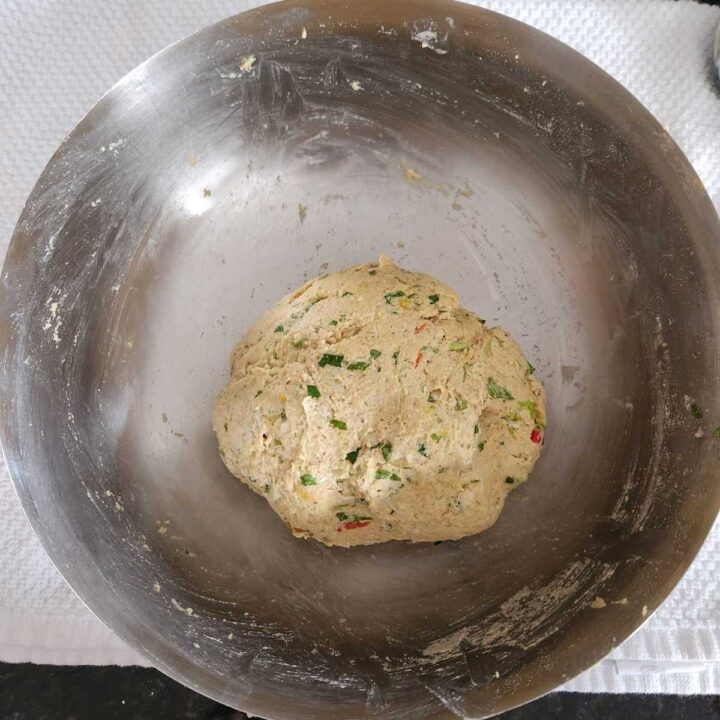
Note: As the dough rests, it will become soft due to the moisture from the lauki.
Make The Parathas: Knead the dough again a couple of times. Divide the dough into 10-12 equal portions, and shape it into balls. Keep it aside.
Take a ball, and dust it with some flour. Place the ball on a rolling surface, and with the help of a rolling pin, roll the ball into a 7-8 inch circle.
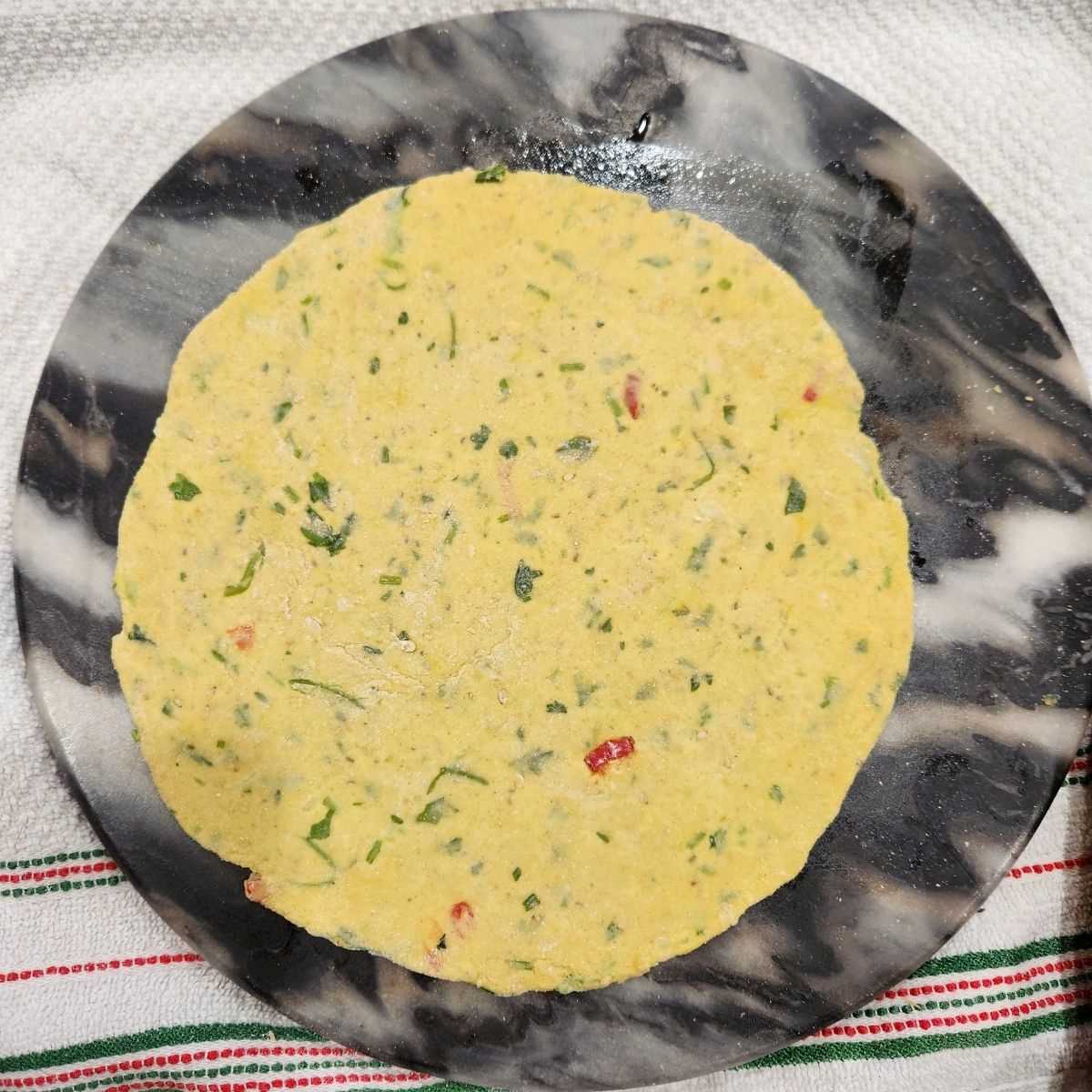
Note: Dust the work surface with some flour, as needed.
Cook the Parathas: Heat a cast-iron tawa or griddle. Place the rolled paratha on the Tawa, and cook it over medium heat.


Drizzle some oil or ghee as needed and cook on both sides. Gently press the paratha with a spatula for even cooking.
Place the paratha in a food warmer lined with a paper towel or a tea towel.
Repeat the process with the remaining dough.
Serve The Parathas: Enjoy lauki paratha with yogurt, Tomato Chutney, Strawberry Jam, pickles, or a piping hot cup of tea. I also like to serve some Aloo Soya(Indian Fried Dill Potatoes) or Aloo Gobi ( Potato Cauliflower Curry) for a complete meal.

Substitutions
Here are some substitutions for the ingredients used in lauki paratha:
Whole Wheat Flour: If you prefer a different type of flour or have dietary restrictions, you can use alternative flours like all-purpose flour, chickpea flour (besan), or a gluten-free flour blend. Keep in mind that the texture and taste of the paratha might vary with different flours.
Grated Bottle Gourd: If bottle gourd is not available, you can substitute it with grated zucchini or grated carrots. These vegetables have similar moisture content and can work well in the paratha.
Carom Seeds: If you don't have carom seeds, you can use cumin seeds. The flavor might be slightly different, but it will still add a warm and earthy taste.
Grated Ginger: Ground ginger or ginger paste can be used as a substitute for freshly grated ginger. However, fresh ginger provides a more intense and aromatic flavor.
Green Chili: If you prefer milder heat, you can use red chili flakes or omit the chili altogether.
Fresh Coriander Leaves: If you don't have fresh coriander leaves, you can use dried coriander leaves (coriander powder) for a milder flavor or substitute with fresh parsley for a similar fresh element.
Ghee or Oil: For a vegan option, use a neutral cooking oil or vegan butter instead of ghee. You can also use coconut oil or avocado oil for a unique flavor.
Variations
There are a few variations to this recipe, that I usually make. My family enjoys a variety of vegetables, so I include them in my paratha. From plain paratha to one with veggies.
I like to add seasonal veggies to make the paratha dough, adding flavor and nutrient value to it. During the summer, I like to add mooli (radish), carrots, cabbage, and beetroot for a nice flavor.
The winter months are great for adding leafy greens such as spinach, dill, or fresh methi leaves (fenugreek leaves).
Mooli (Radish) Paratha: If you like stuffed mooli paratha and find it hard to make. Then try adding mooli to the dough, you will love this recipe.
Mooli paratha is yet another winner with its simple, rustic flavor. Use a small grated mooli, about 2 cups to prepare the dough.
Like lauki, mooli releases a lot of moisture. Do not keep the dough for very long. I like to add some garam masala to the mooli paratha for that extra flavor.
Veggie Paratha: Veggies like cabbage, carrot, and beetroot, add a nice color and flavor to the paratha. Simply grate the veggies finely and add them to the dough. Enjoy veggies paratha with some yogurt for a complete meal.
Leafy Green Paratha: Spinach, fresh methi leaves or dill, all are a great addition to this lauki paratha. I finely chop the greens and add it to the dough.
Kasuri Methi Paratha: Fresh methi leaves can be replaced with dried fenugreek leaves known as Kasuri methi. Add about 2 tablespoons of dried Kasuri methi to make the dough. Serve paratha with some half-fried egg.
Spicy Lauki Paratha: Increase the amount of green chilies, red chili powder, and other spices for a spicier version. You can also add a dash of black pepper for extra heat.
Herbed Lauki Paratha: Add chopped fresh herbs like mint, cilantro, or basil to the paratha dough for a refreshing and aromatic twist. We love paratha with some Kashmiri Paneer Masala, Baingan Bharta or Tomato Chokha.
Paneer (Cottage Cheese) and Lauki Paratha: Combine grated paneer with grated lauki for a protein-packed variation that's creamy and satisfying.
Multigrain Lauki Paratha: Combine different types of flours like whole wheat, besan (chickpea flour), and millet flour to create a multigrain dough. This adds variety and nutritional value.

Storage
Store cooked lauki parathas by stacking them in an airtight container, and refrigerating for 1-2 days or freeze for up to 2-3 months.
If planning on freezing the paratha, partially cook the paratha, and cool them completely. Layer a piece of parchment paper between the paratha. Store it in a Ziploc bag or freezer-safe container.
Defrost or in a microwave for 10 seconds. Heat the griddle, and cook the paratha on both sides. Apply some oil as needed. Serve hot.
Tips
The Consistency Of The Dough: It is neither too wet nor too dry. It should be semi-soft, and non-sticky. If the dough is sticky, mix a tablespoon of flour at a time, to achieve a non-sticky dough consistency. If you feel the dough is too dry, add 1-2 tablespoons of water, and foam it into a soft dough.
Rest The Dough: It is important to rest the dough for 5-10 minutes. Resting the dough allows the gluten in the dough to relax, and makes it easier to work with the dough.
Even Rolling: Roll out the dough evenly to create a consistent thickness across the entire paratha. This ensures even cooking and prevents areas from being undercooked or overcooked.
Heat The Tawa (Griddle): Heat the tawa or griddle over medium heat and then place the paratha on it. Before cooking on a cast-iron tawa or griddle, make sure it is well seasoned.
Avoid Overcooking: Cook the paratha on medium heat for even cooking. Apply some ghee/oil as needed, for moist, soft paratha.
Use Flour Sparingly: While rolling, use minimal flour to prevent the parathas from becoming dry or tough. Dust the rolling surface and rolling pin as needed.
Ghee for Flavor: Applying ghee or oil while cooking adds flavor and helps achieve a crispy texture. You can brush the paratha with ghee or oil on both sides during cooking.
Serve Fresh: Parathas are best enjoyed immediately after cooking, so try to serve them hot off the griddle for the best flavor and texture.
Store Paratha Properly: Place the paratha in a food warmer or air-tight container lined with a paper towel or a tea towel.

Pairing
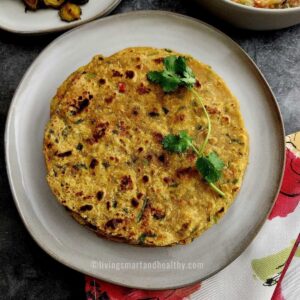
Lauki Paratha (Bottle Gourd Flatbread)
Equipment
Ingredients
- 2 cups bottle gourd (lauki), grated
- 2 cups whole wheat flour (atta)
- 2 tablespoon gram flour (besan)
- 1 cup fresh cilantro, chopped
- 1- inch ginger, finely grated
- 2-3 green chili, finely chopped; adjust to taste
- ½ teaspoon carom seeds (ajwain)
- ½ teaspoon red chili powder ; adjust to taste
- ½ teaspoon turmeric powder
- 2 teaspoons coriander powder
- salt to taste
- 1 teaspoon canola oil
- ½-3/4 cup water for kneading or as required
- Additional flour for dusting / rolling the paratha
- Ghee or oil for cooking the paratha as needed ( For Vegan use oil )
Instructions
- Wash and peel the bottle gourd.
- Use a food processor or box grater to grate lauki.
- Add all the ingredients to a large bowl. Mix well.
- Gradually add water and bind the dough into a firm dough. Apply a teaspoon of oil, cover, and let the dough rest for 5-10 minutes.Note: As the dough rests, it will become soft due to the moisture from the lauki.
- Knead the dough again a couple of times. Divide the dough into 10-12 equal portions, and shape it into balls. Keep it aside.
- Take a ball, and dust it with some flour. Place the ball on a rolling surface, and with the help of a rolling pin, roll the ball into a 7-8 inch circle.
- Heat the Tawa / Griddle. Place the rolled paratha on the tawa, and cook it over medium heat.
- Drizzle some Ghee/oil as needed and cook on both sides. Gently press the thepla with a spatula for even cooking.
- Place the paratha in a food warmer lined with a paper towel or a tea towel.
- Repeat the process with the remaining dough.
- Enjoy lauki paratha with Tomato Chutney, yogurt, Homemade Strawberry Jam, or a piping hot cup of tea.
Nutrition
Disclaimer
Nutrition values are my best estimates. If you rely on them for your diet, use your preferred nutrition calculator.






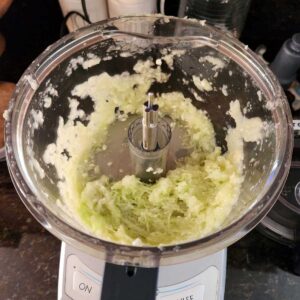


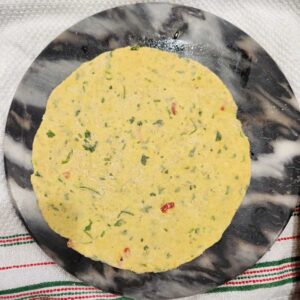
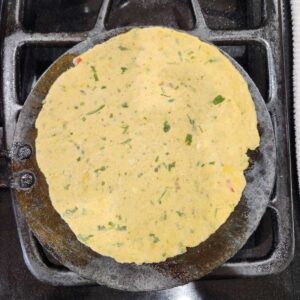
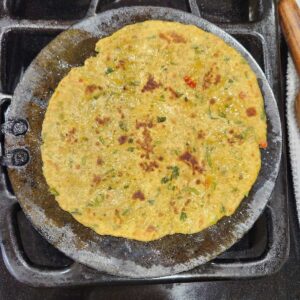








Vegan Recipes says
We loved this! It's perfect for breakfast or snack on the go! So convenient that can be made ahead and frozen. Great recipe!
Jyoti Behrani says
Awesome! I am so glad you liked my recipe 🙂